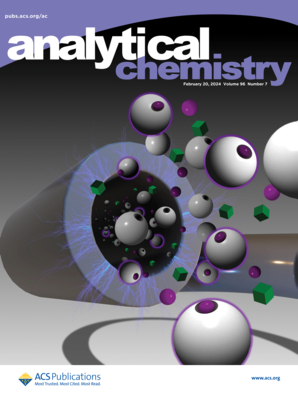高通量单细胞质谱分析揭示斑马鱼肝细胞对 6:2 氯化多氟醚磺酸盐的代谢反应具有性别特异性
IF 6.7
1区 化学
Q1 CHEMISTRY, ANALYTICAL
引用次数: 0
摘要
化合物6:2氯化多氟烷基醚磺酸盐(6:2 Cl-PFESA)是一种新兴的全氟烷基和多氟烷基物质(PFAS),对生物系统和生态系统具有潜在的毒性和健康风险。在这里,我们建立了一种基于单细胞质谱的代谢组学方法来研究暴露于6:2 Cl-PFESA的斑马鱼的肝毒性和异质性反应。将斑马鱼暴露于环境相关浓度(200 ng/L)的6:2 Cl-PFESA中14天。将肝脏解离制备成细胞悬液,然后引入高通量单细胞质谱法,分析单个原代肝细胞中6:2 Cl-PFESA和内源性代谢物。在6:2的Cl-PFESA积累中观察到显著的性别特异性异质性(p <;0.05)。代谢组学分析显示,斑马鱼肝细胞中的脂质代谢受到干扰,特别是不饱和脂肪酸、醚类脂和鞘脂受到影响,表明潜在的肝毒性。性别依赖的代谢反应是明显的:雄性在葡萄糖和脂肪酸代谢方面表现出显著的变化,而雌性在甘油磷脂和氨基酸途径方面表现出明显的破坏。ROC分析确定了性别特异性生物标志物,包括男性FA(18:3)和FA(16:1) (AUC >;0.85),女性的脯氨酸和磷脂酰胆碱(AUC >;0.90)。这些发现反映了代谢失调,并突出了性别特异性反应。本研究证明了单细胞代谢组学在阐明污染物暴露的细胞机制和代谢反应方面的可行性,为在单细胞水平上进行精确和全面的毒性评估提供了见解。本文章由计算机程序翻译,如有差异,请以英文原文为准。

High-Throughput Single-Cell Mass Spectrometry Reveals Sex-Specific Metabolic Responses to 6:2 Chlorinated Polyfluoroalkyl Ether Sulfonate in Zebrafish Liver Cells
Compound 6:2 chlorinated polyfluoroalkyl ether sulfonate (6:2 Cl-PFESA) is an emerging per- and polyfluoroalkyl substance (PFAS) with potential toxicity and health risks to biosystems and ecosystems. Here, we developed a metabolomics method based on single-cell mass spectrometry to investigate the hepatotoxicity and heterogeneous responses in zebrafish exposed to 6:2 Cl-PFESA. Zebrafish were exposed to an environmentally relevant concentration (200 ng/L) of 6:2 Cl-PFESA for 14 days. The livers were dissociated and prepared as cell suspensions and then introduced to high-throughput single-cell mass spectrometry for analysis of 6:2 Cl-PFESA and endogenous metabolites in individual primary liver cells. Significant sex-specific heterogeneity in 6:2 Cl-PFESA accumulation was observed (p < 0.05). Metabolomics analysis revealed perturbations in lipid metabolism, particularly affecting unsaturated fatty acids, ether lipids, and sphingolipids in zebrafish liver cells, indicating potential hepatotoxicity. Sex-dependent metabolic responses were evident: males showed notable changes in glucose and fatty acid metabolism, whereas females experienced pronounced disruptions in glycerophospholipid and amino acid pathways. ROC analysis identified sex-specific biomarkers, including FA(18:3) and FA(16:1) in males (AUC > 0.85), as well as proline and phosphatidylcholine in females (AUC > 0.90). These findings reflect metabolic dysregulation and highlight sex-specific responses. This study demonstrates the feasibility of single-cell metabolomics to elucidate the cellular mechanisms and metabolic responses of pollutant exposure, offering insights into precise and comprehensive toxicity assessments at the single-cell level.
求助全文
通过发布文献求助,成功后即可免费获取论文全文。
去求助
来源期刊

Analytical Chemistry
化学-分析化学
CiteScore
12.10
自引率
12.20%
发文量
1949
审稿时长
1.4 months
期刊介绍:
Analytical Chemistry, a peer-reviewed research journal, focuses on disseminating new and original knowledge across all branches of analytical chemistry. Fundamental articles may explore general principles of chemical measurement science and need not directly address existing or potential analytical methodology. They can be entirely theoretical or report experimental results. Contributions may cover various phases of analytical operations, including sampling, bioanalysis, electrochemistry, mass spectrometry, microscale and nanoscale systems, environmental analysis, separations, spectroscopy, chemical reactions and selectivity, instrumentation, imaging, surface analysis, and data processing. Papers discussing known analytical methods should present a significant, original application of the method, a notable improvement, or results on an important analyte.
 求助内容:
求助内容: 应助结果提醒方式:
应助结果提醒方式:


